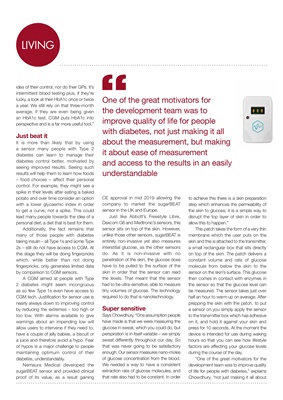
LIVINGLIVING
idea of their control, nor do their GPs. It's
intermittent blood testing plus, if they're
lucky, a look at their HbA1c once or twice
a year. We still rely on that three-month
average, if they are even being given
an HbA1c test. CGM puts HbA1c into
perspective and is a far more useful tool."
Just beat it
It is more than likely that by using a sensor
many people with Type 2 diabetes can
learn to manage their diabetes control
better, motivated by seeing improved
results. Seeing such results will help them
to learn how foods - food choices - affect
their personal control. For example, they
might see a spike in their levels after
eating a baked potato and over time
consider an option with a lower glycaemic
index in order to get a curve, not a spike.
This could lead many people towards the
idea of a personal diet, a diet that is best
for them.
Additionally, the fact remains that
many of those people with diabetes
taking insulin - all Type 1s and some Type
2s - still do not have access to CGM. At
this stage they will be doing fingerpricks
which, while better than not doing
fingerpricks, only generates limited data
by comparison to CGM sensors.
A CGM aimed at people with Type
2 diabetes might seem incongruous
as so few Type 1s even have access to
CGM tech. Justification for sensor use is
nearly always down to improving control
by reducing the extremes - too high or
too low. With alarms available to give
warnings about an impending low will
allow users to intervene if they need to,
have a couple of jelly babies, a biscuit or
a juice and therefore avoid a hypo. Fear
of hypos is a major challenge to people
maintaining optimum control of their
diabetes, understandably.
Nemaura Medical developed the
sugarBEAT sensor and provided clinical
proof of its value, as a result gaining
CE approval in mid 2019 allowing the
company to market the sugarBEAT
sensor in the UK and Europe.
Just like Abbott's Freestyle Libre,
Dexcom G6 and Medtronic's sensors, this
sensor sits on top of the skin. However,
unlike those other sensors, sugarBEAT is
entirely non-invasive yet also measures
interstitial glucose, as the other sensors
do. As it is non-invasive with no
penetration of the skin, the glucose does
have to be pulled to the surface of the
skin in order that the sensor can to read
the levels. That meant that the sensor
had to be ultra-sensitive, able to measure
tiny volumes of glucose. The technology
required to do that is nanotechnology.
Super sensitive
Says Chowdhury, "One assumption
people have made is that we were
measuring the glucose in sweat, which
you could do, but perspiration is in itself
variable - we simply sweat differently
throughout our day. So that was never
going to be satisfactory enough. Our
sensor measures nano-moles of glucose
concentration from the blood. We needed
a way to have a consistent extraction rate
of glucose molecules, and that rate also
had to be constant. In order to achieve
this there is a skin preparation step which
enhances the permeability of the skin to
glucose; it is a simple way to disrupt the
top layer of skin in order to allow this to
happen."
This patch takes the form of a very thin
membrane which the user puts on the
skin and this is attached to the transmitter,
a small rectangular box that sits directly
on top of the skin. The patch delivers a
constant volume and rate of glucose
molecule from below the skin to the
sensor on the skin's surface. This glucose
then comes in contact with enzymes in
the sensor so that the glucose level can
be measured. The sensor takes just over
half an hour to warm up on average. After
prepping the skin with the patch, to put
a sensor on you simply apply the sensor
to the transmitter box which has adhesive
on it, and hold it against your skin and
press for 10 seconds. At the moment the
device is intended for use during waking
hours so that you can see how lifestyle
One of the great motivators for the
development team was to improve
quality of life for people with diabetes,
not just making it all about the
measurement, but making it about
ease of measurement and access to
the results in an easily understandable
way. - Faz Chowdhury
"